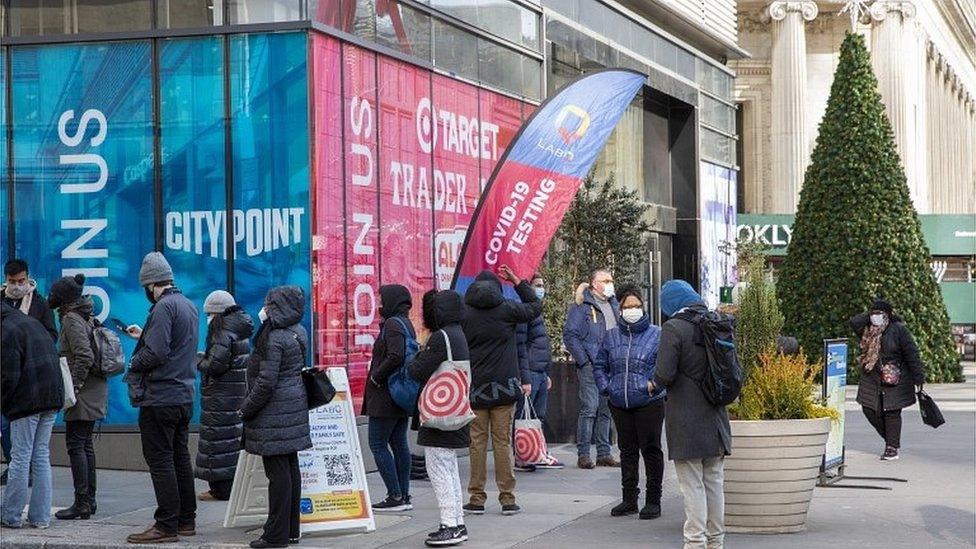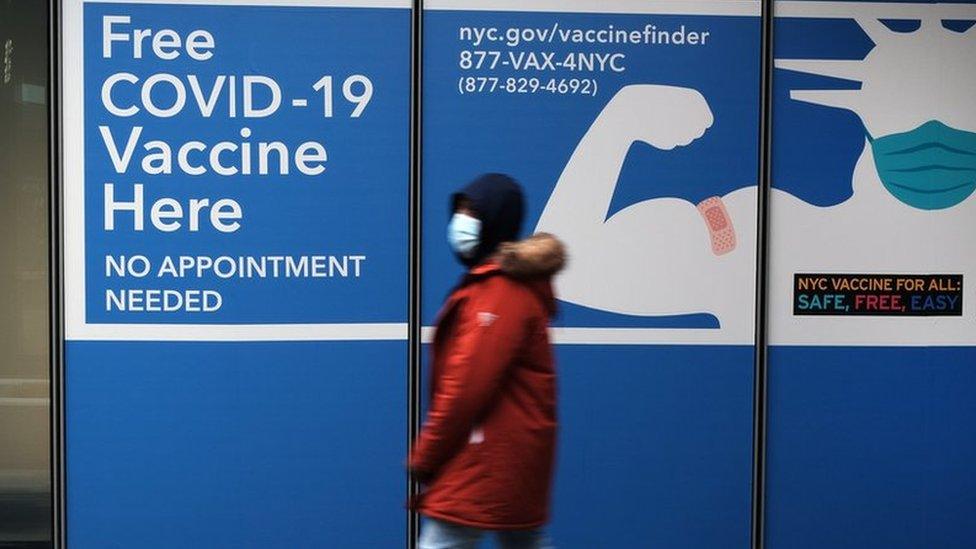Covid: US halves isolation time for asymptomatic infection
- Published

There have been long queues at testing sites throughout the holiday period
US health officials have halved the recommended isolation time for people with asymptomatic Covid-19 from 10 to five days, amid a surge in cases.
The measure is expected to alleviate disruption caused by staff shortages in many areas because of infections.
The Centers for Disease Control (CDC) says most transmissions happen in the two days before and three days after symptoms develop.
But experts have criticised the lack of testing requirements to end isolation.
The sharp rise in cases has been fuelled by the Omicron variant of the virus, which is now dominant in the US. Early studies suggest Omicron is more contagious than other variants, although milder.
The growing number of people having to isolate has put pressure on several industries, including air travel, with thousands of flights cancelled during the Christmas holiday.
Leaders of major US airlines were among those calling for the change, as cancellations continued for a fourth day on Tuesday.
The CDC said the new guidance was "motivated by science", and that the isolation must be followed by five days of wearing a mask around others. The announcement came as more than 200,000 daily infections were confirmed in the past two days nationwide.
CDC director Dr Rochelle Walensky said the recommendation "balances what we know about the spread of the virus and the protection provided by vaccination and booster doses".
"These updates ensure people can safely continue their daily lives," Dr Walensky said in a statement., external
Watch: How an iconic Manhattan magazine shop survived the pandemic
But there was no recommendation for people to take rapid at-home tests before the end of their isolation periods. Many experts say such tests help to show whether people continue to spread the virus.
Dr Michael Mina, an assistant professor at Harvard TH Chan School of Public Health, called the lack of such requirement "reckless".
"I absolutely don't want to sit next to someone who turned Positive 5 days ago and hasn't tested [negative]," he said on Twitter., external
In England, people are now required to isolate for seven days, instead of 10, with two negative lateral flow tests needed to end their self-isolation - the first no earlier than day six of isolation and a second 24 hours later.
Speaking on CNN,, external the top US infectious disease expert said the CDC decision would allow people to return to work more quickly, calling it "very prudent" and a "good choice".
"With the sheer volume of new cases that we're having and that we expect to continue with Omicron, one of the things we want to be careful of is that we don't have so many people out," Dr Anthony Fauci, who also serves as President Joe Biden's chief medical adviser, said.

Balancing the risks

Infectiousness is not like a switch. It does not just go on to off. Instead, people with Covid gradually go from a period of peak infectiousness to lower infectiousness.
The most infectious period starts a few days before symptoms develop. This is one of the reasons why the virus is so hard to contain. After about five days, the risk of passing on the virus will start to decline for most people.
But it is still possible to pass on the virus. That is why when countries started introducing isolation periods many went for 14 days. It was a belt-and-braces approach. But over time these isolation periods have been reduced, reflecting the reduced threat the virus presents as vaccines have been rolled out.
In England it has now been set at seven days if you are negative using a rapid test. That should give people a good idea if they have passed peak infectiousness and reflects the fact the UK has made these rapid tests easily accessible to everyone.
The US approach for people without symptoms is grounded in research that suggests these cases are likely to be less infectious to start with. At the end of the day, it is all about balancing the risks - from both the virus and our responses to it.

The CDC also shortened the quarantine period for people exposed to someone infected. Unvaccinated people will be required to quarantine for five days after exposure, down from 14.
The same applies to people who were more than six months on from their second dose of the Pfizer or Moderna vaccines, or two months after a Johnson & Johnson dose, and had not yet received a booster shot.
Last week, the CDC reduced the recommended isolation time for asymptomatic health workers from 10 to seven days. But they were required to take a test to end their isolation period.
While the new recommendations are not mandatory, they are closely followed by many businesses and policymakers across the US.
EXPLAINER: Omicron up to 70% less likely to need hospital care
IN CHARTS: Tracking the pandemic
On Monday, President Biden pledged to deal with a shortage of tests as Omicron threatens to overwhelm hospitals.
"Seeing how tough it was for some folks to get a test this weekend shows that we have more work to do," he said as he joined a call with the administration's Covid response team and state governors. "It's clearly not enough."
New steps will include improving at-home test manufacturing and making it easier to use Google to locate nearby test centres, he said.
Different states and local authorities in the US are introducing new measures in a bid to combat rising cases. New vaccine requirements have come into force in New York City, including a vaccine mandate for private-sector workers in the city.
Related topics
- Published27 December 2021
